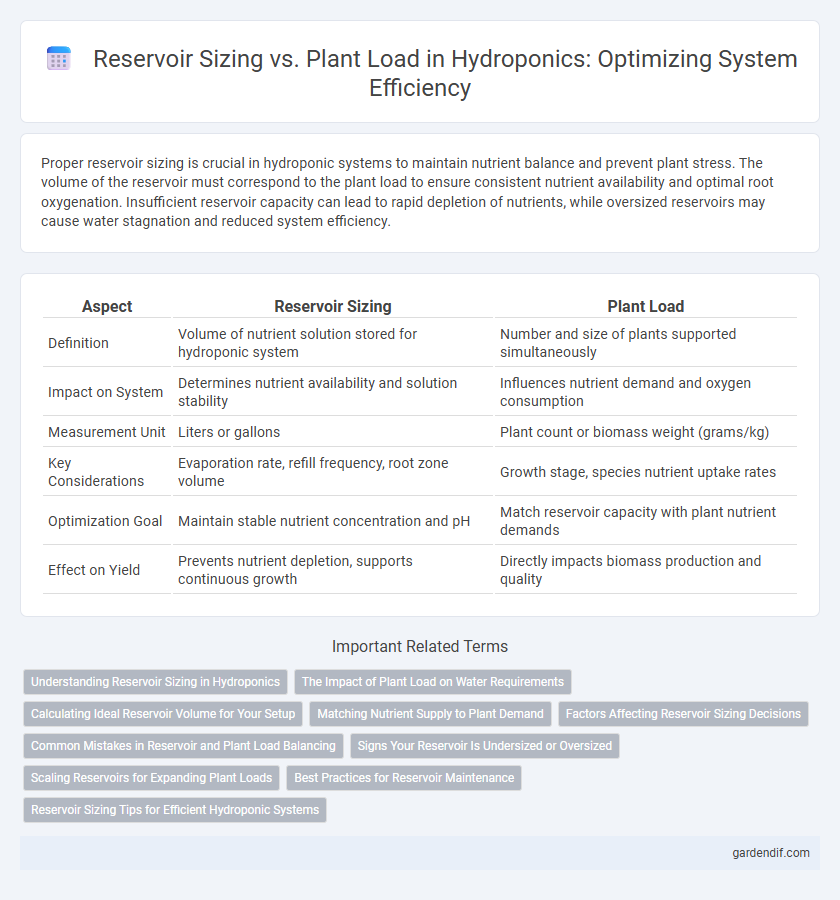
Reservoir Sizing vs Plant Load Illustration
Proper reservoir sizing is crucial in hydroponic systems to maintain nutrient balance and prevent plant stress. The volume of the reservoir must correspond to the plant load to ensure consistent nutrient availability and optimal root oxygenation. Insufficient reservoir capacity can lead to rapid depletion of nutrients, while oversized reservoirs may cause water stagnation and reduced system efficiency.
Table of Comparison
| Aspect | Reservoir Sizing | Plant Load |
|---|---|---|
| Definition | Volume of nutrient solution stored for hydroponic system | Number and size of plants supported simultaneously |
| Impact on System | Determines nutrient availability and solution stability | Influences nutrient demand and oxygen consumption |
| Measurement Unit | Liters or gallons | Plant count or biomass weight (grams/kg) |
| Key Considerations | Evaporation rate, refill frequency, root zone volume | Growth stage, species nutrient uptake rates |
| Optimization Goal | Maintain stable nutrient concentration and pH | Match reservoir capacity with plant nutrient demands |
| Effect on Yield | Prevents nutrient depletion, supports continuous growth | Directly impacts biomass production and quality |
Understanding Reservoir Sizing in Hydroponics
Reservoir sizing in hydroponics directly impacts nutrient availability and plant health by ensuring an adequate volume to support the plant load and maintain stable environmental conditions. Properly sized reservoirs prevent rapid nutrient depletion and pH fluctuations, allowing roots to receive consistent oxygen and nutrient delivery essential for optimal growth. Balancing reservoir capacity with plant demand minimizes water stress and optimizes overall system efficiency for sustained hydroponic productivity.
The Impact of Plant Load on Water Requirements
Plant load directly influences reservoir sizing by determining the volume of nutrient solution needed to sustain optimal growth in hydroponic systems. Higher plant densities increase water uptake and nutrient consumption, necessitating larger reservoirs to maintain stable solution concentrations and prevent stress. Precise calculation of reservoir capacity based on plant load ensures efficient water use and consistent crop yields.
Calculating Ideal Reservoir Volume for Your Setup
Calculating the ideal reservoir volume for a hydroponic system hinges on the plant load, with a general recommendation of 1 to 2 gallons of water per plant to ensure adequate nutrient availability and oxygenation. Maintaining a properly sized reservoir prevents nutrient imbalances and root diseases by allowing stable environmental conditions and consistent nutrient delivery. Optimal reservoir sizing also supports efficient water use and system stability, critical for maximizing crop yield and health in hydroponic cultivation.
Matching Nutrient Supply to Plant Demand
Proper reservoir sizing in hydroponic systems directly influences the balance between nutrient supply and plant load, ensuring optimal growth conditions. A reservoir too small may lead to nutrient depletion, causing deficiencies, while an oversized reservoir can result in stagnation and nutrient imbalances. Matching reservoir volume to plant demand maintains consistent nutrient availability, supporting healthy root development and maximizing yield.
Factors Affecting Reservoir Sizing Decisions
Reservoir sizing in hydroponic systems is primarily influenced by plant load, which dictates the nutrient solution volume required to support optimal growth. Key factors affecting reservoir size decisions include the density of plants per unit area, their growth stage, and evaporation rates, which together impact the frequency of nutrient replenishment and oxygen levels. Environmental conditions such as temperature and humidity also play critical roles, as they alter water uptake and transpiration rates, further shaping reservoir capacity requirements.
Common Mistakes in Reservoir and Plant Load Balancing
Common mistakes in reservoir sizing versus plant load in hydroponic systems include underestimating the water volume needed to support peak plant demand and neglecting the dynamic nutrient uptake rates of different crops. Incorrect reservoir volumes can lead to frequent nutrient imbalances, oxygen depletion, and root stress, compromising plant growth and yield. Precise calculations that account for plant transpiration rates, growth stage variations, and system recirculation ensure optimal reservoir sizing and balanced nutrient delivery.
Signs Your Reservoir Is Undersized or Oversized
An undersized hydroponic reservoir often exhibits frequent nutrient imbalances, rapid pH fluctuations, and increased temperature variability, leading to stunted plant growth and nutrient deficiencies. Conversely, an oversized reservoir may cause stagnant water conditions, reduced oxygen levels, and excessive nutrient buildup, which can promote root diseases and algae growth. Monitoring plant load relative to reservoir volume is crucial to maintain optimal nutrient delivery and prevent these detrimental signs.
Scaling Reservoirs for Expanding Plant Loads
Scaling hydroponic reservoirs requires careful consideration of the plant load to ensure optimal nutrient delivery and root zone oxygenation. Reservoir volume should increase proportionally to the plant count and their growth stage to prevent nutrient depletion and maintain stable pH levels. Properly sizing reservoirs supports efficient water use, maximizes yield, and reduces the risk of pathogen buildup in expanding hydroponic systems.
Best Practices for Reservoir Maintenance
Proper reservoir sizing in hydroponic systems depends on plant load, ensuring adequate nutrient and oxygen supply to meet growth demands and prevent root stress. Best practices for reservoir maintenance include regular monitoring of pH, electrical conductivity (EC), and temperature to sustain optimal nutrient availability and prevent pathogen growth. Flushing and replacing the reservoir solution periodically minimizes salt buildup and maintains a stable root environment for consistent crop yields.
Reservoir Sizing Tips for Efficient Hydroponic Systems
Proper reservoir sizing in hydroponic systems is critical for maintaining nutrient balance and ensuring optimal plant growth, with the ideal volume typically ranging from 0.5 to 1 gallon per plant depending on species and growth stage. Oversized reservoirs can lead to stagnant nutrient solutions, while undersized reservoirs demand frequent refilling and adjustment, impacting system stability. Monitoring plant load relative to reservoir capacity helps optimize oxygenation, nutrient delivery, and overall system efficiency.
Reservoir Sizing vs Plant Load Infographic

 gardendif.com
gardendif.com